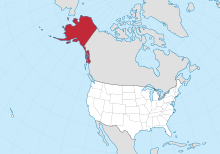
Paleontology in Alaska refers to paleontological research occurring within or conducted by people from the U.S. state of Alaska. During the Late Precambrian, Alaska was covered by a shallow sea that was home to stromatolite-forming bacteria. Alaska remained submerged into the Paleozoic era and the sea came to be home to creatures including ammonites, brachiopods, and reef-forming corals. An island chain formed in the eastern part of the state. Alaska remained covered in seawater during the Triassic and Jurassic. Local wildlife included ammonites, belemnites, bony fish and ichthyosaurs. Alaska was a more terrestrial environment during the Cretaceous, with a rich flora and dinosaur fauna.
During the early Cenozoic, Alaska had a subtropical environment. The local seas continued to drop until a land bridge connected the state with Asia. Early humans crossed this bridge and remains of contemporary local wildlife such as woolly mammoths often show signs of having been butchered.
More recent Native Americans interpreted local fossils through a mythological lens. The local fossils had attracted the attention of formally trained scientists by the 1830s. Major local finds include the Kikak-Tegoseak Pachyrhinosaurus bonebed. The Pleistocene-aged woolly mammoth, Mammuthus primigenius is the Alaska state fossil.